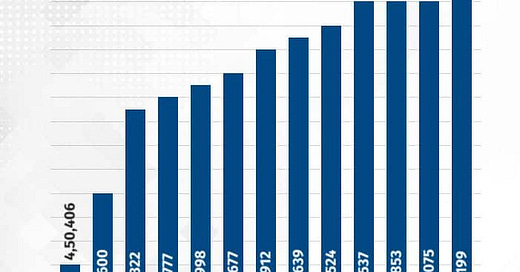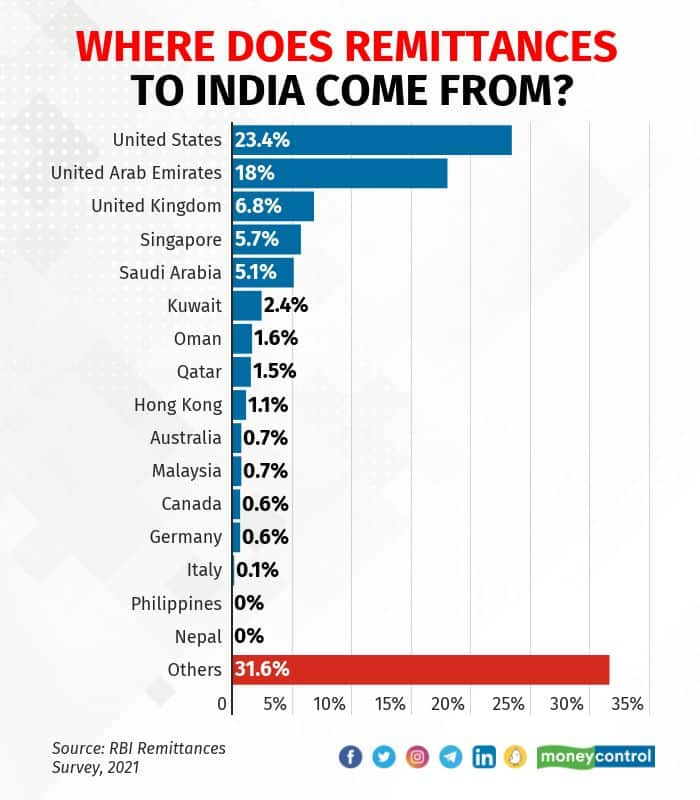Will Trump 2.O shatter the Indian hope of the American Dream?
Under Trump, the only certainty is uncertainty.
Donald Trump’s second act in the Oval Office has kicked off with the kind of drama you’d expect from the man who coined “Make America Great Again.” But while the MAGA hats are back in style for some, many Indians—both in the United States and at home—are nervously watching for the next policy announcement that might scramble their best-laid plans.
In the last few years of Trump’s first term, H-1B visa denials increased by nearly 24% (compared to an average of around 6% in the final year of the Obama administration), according to a 2020 report by the National Foundation for American Policy (NFAP). With Trump 2.O, those numbers might climb again. It’s not just about the statistics, though; it’s about the uncertainty hanging in the air. After all, if the president can shift immigration policy with the stroke of a pen, that unpredictability can be nerve-wracking for anyone living on a work visa, or dreaming of getting one.
For context, Indian nationals have historically filed the majority of H-1B petitions—in fiscal year 2021, they accounted for more than 74% of all approved H-1B visas (U.S. Citizenship and Immigration Services data). That’s a huge chunk of the Indian diaspora’s professional population in the U.S., and they’re all holding their breath for what Trump might do next.
Visa Turbulence: H-1B & Beyond
The H-1B program has long been the golden ticket for many Indian techies eyeing Silicon Valley. In years past, it wasn’t exactly easy to get in, but it was predictable: apply in April, hope for the lottery, and if you’re qualified, you had a decent shot. Trump changed that game during his first term with tighter scrutiny. Requests for Evidence (RFEs) went up by 44% between 2017 and 2019 (USCIS data), causing headaches for applicants and employers alike.
As he settles back into the White House, another wave of policy shifts making the H-1B process even more stringent is to be expected. Whether it’s raising the prevailing wage levels—making it tougher for smaller companies to hire—or limiting the job roles considered “specialized,” the ripple effects will extend beyond coders and engineers. Even university researchers and healthcare professionals might find themselves struggling for visa approvals.
And remember, H-1B isn’t the only game in town. OPT (Optional Practical Training) for international students is also in the crosshairs if the administration decides it’s another loophole letting foreigners take American jobs. For Indian students with big dreams of a U.S. education (and the hope of working stateside after graduation), that uncertainty is no small matter.
H-4 EAD in the Crosshairs
One of the most significant policy changes under Trump’s first term was the threat to end H-4 EAD, the work authorization for spouses of H-1B holders. While it never fully disappeared, the administration came close to revoking it entirely, leaving thousands of families in limbo. For dual-income households, losing the H-4 EAD can mean uprooting a life they’ve spent years building.
Data from the Migration Policy Institute (2021) suggests that over 90% of H-4 EAD holders are women, many of them highly skilled professionals themselves. If Trump pushes forward with renewed efforts to strip away the EAD, we could see a wave of Indian spouses forced out of the workforce—or opting to leave the U.S. altogether. It’s not just a policy footnote; it’s a potential socio-economic setback for countless families.
Chain Migration on the Chopping Block
“Chain migration” has been a favorite target of Trump’s rhetoric, referring to the process by which legal residents sponsor relatives to join them in the U.S. For us Indians, family ties run deep—parents, siblings, children, and extended families often live under one roof or at least within the same zip code. In the U.S. immigration context, family sponsorship has long been a safety net for keeping loved ones together.
Under Trump 2.O, don’t be surprised if the administration revisits proposals to limit family-based immigration. It is well known - and a common joke - that waiting times for family-based green cards are already years (sometimes decades) long for Indian nationals, according to the State Department Visa Bulletin. Tighter caps or additional scrutiny could stretch those timelines even further, leaving countless families in limbo.
Ripples in the Tech World
It’s no secret that Indian tech professionals drive a large portion of America’s innovation economy. Many of those whiz kids in Silicon Valley startups or big tech companies like Google, Microsoft, and Amazon either started out on an F-1 student visa or came through the H-1B system. In 2020 alone, Indian nationals made up 67% of tech immigrants in the U.S. (NFAP).
But if the U.S. door slams shut, the world won’t stand still. Canada, for instance, has actively wooed Indian tech talent, offering straightforward immigration pathways and PR options. Toronto’s booming tech scene has been dubbed “The Silicon Valley of the North,” partly because of the influx of Indian engineers who found the American route too cumbersome. Companies themselves are looking at nearshore or offshore expansions to keep projects rolling without the red tape—meaning big opportunities for places like Mexico or Eastern Europe. It’s a real possibility that the next big startup could be born in Vancouver or Berlin (or even perhaps our very own Bangalore), instead Seattle or San Jose.
A Shift in Global Talent Flows
Beyond tech, the entire ecosystem of global talent could feel the shockwaves of Trump’s second stint. If you’re a biomedical researcher or a manufacturing specialist, you might reconsider the U.S. route, opting for countries that roll out a clearer red carpet. Fewer Indians heading stateside also means fewer dollars sent back home. Remittances to India hit a record $100 billion in 2022, according to the World Bank, a chunk of which originates from the United States. If that pipeline slows, families in India could feel the pinch, especially in sectors reliant on those extra funds.
Moreover, some Indian companies might choose to ramp up local hiring in the U.S. to avoid visa hassles, which indirectly curtails the number of Indians traveling abroad for those “on-site” assignments. In the grand chessboard of global labor, every move has multiple knock-on effects—and Trump 2.0 is a move that could reshape entire industries.
Trade Policies & Tariff Tensions
Trump’s trade approach often involves tough talk and tougher tariffs. We saw it happen with China, and India wasn’t exactly spared. In 2018-2019, India faced increased tariffs on steel and aluminum exports to the U.S., leading to a mini trade spat and retaliatory measures. Now, with talk of “reciprocal tariffs” making a comeback, Indian exports like pharmaceuticals and textiles could get caught in the crosshairs yet again.
Pharma is a particularly delicate area—India supplies nearly 40% of generic drugs consumed in the U.S. (U.S. Food and Drug Administration data). If Trump decides to hike tariffs or impose new barriers, that could raise the already sky-high healthcare costs for American consumers and slice into the profits of Indian pharma giants. Both sides lose in a tariff war, but that hasn’t always deterred Trump from pulling the trigger.
One of the more dramatic rumors swirling around is Trump’s threat to slap a 100% tariff on a hypothetical BRICS currency if it ever materializes. It is impossible to ascertain if this was a serious claim or just nonsense (that he spews on a frequent basis). A hypothetical to the hypothetical: would such a move drive BRICS countries closer together in defiance, or fracture the group further? Right now, it’s anyone’s guess.
A Small Glimmer of Silver
Not everything is doom and gloom. Trump’s well-known distrust of China could lead to supply chain diversifications—many U.S. companies might look to India as a Plan B or C. If the Indian government plays its cards right, it could attract a significant share of the manufacturing pivot. In 2022, Apple began ramping up iPhone production in India, a move analysts predict could generate thousands of jobs over the next few years.
Could we see a surge in automotive or electronics manufacturers following suit? Hopefully. Stronger ties here mean more foreign investment, which could partially offset some of the negative impacts from the immigration clampdowns. The question is whether India can create the right environment—regulatory, infrastructural, and financial—to grab the opportunity.
NAVIGATING TRUMP 2.0
Trump has always had a knack for commanding the spotlight. His second term is no different, spurring a new wave of memes, Twitter hot takes, and WhatsApp forwards dissecting his every word. Sure, we laugh at the late-night TV jokes, but the pop culture phenomenon has real-life effects. It shapes public opinion, fuels heated debates, and sometimes distracts from the hard policy shifts happening behind the curtain.
So, what’s an Indian student, professional, or entrepreneur to do? Step one: stay informed. Policies can change on a dime, and misinformation runs rampant on social media. Check reputable sources—USCIS, NFAP, or trusted news outlets—for updates. Step two: be prepared with a Plan B. That might mean exploring alternatives like Canada or Europe for career growth, or diversifying your skill set to fit the “specialized” roles that have a better shot at visa approvals.
If you’re an employer in India, it’s time to think about expanding globally in ways that don’t rely entirely on U.S. work visas. Consider nearshoring or remote work models—two strategies that gained traction during the pandemic and are still going strong. Families reliant on remittances might need to tighten budgets or look for supplemental income streams, just in case the U.S. pipeline slows.






